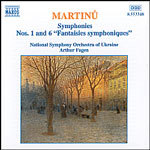
Symphonies Nos. 1 and 6 'Fantaisies symphoniques'
 $25.00
Out of Stock
$25.00
Out of Stock6+ weeks add to cart
MARTINU
Symphonies Nos. 1 and 6 'Fantaisies symphoniques'
Ukraine National Symphony Orchestra / Arthur Fagen (conductor)
[ Naxos / CD ]
Release Date: Thursday 11 November 2004
This item is currently out of stock. It may take 6 or more weeks to obtain from when you place your order as this is a specialist product.
"Arthur Fagen and his Ukrainian orchestra give convincing accounts of both symphonies, and with the help of a sympathetic recording, they achieve that wonderfully luminous, glowing sound which is a special feature of Martinu's orchestral music" - BBC Music Magazine
"Arthur Fagen and his Ukrainian orchestra give convincing accounts of both symphonies, and with the help of a sympathetic recording, they achieve that wonderfully luminous, glowing sound which is a special feature of Martinu's orchestral music"
- BBC Music Magazine
The Czech composer Bohuslav Martinu was born in 1890 at Policka in Bohemia in a bell-tower. where his father, a shoe-maker by trade, was employed as watchman. In his childhood he learned the violin from a local tailor and made a local reputation for himself, giving his first public concert in his home-town in 1905. At the same time he concentrated attention on composition, although without proper tuition and lacking even the necessary manuscript-paper for the purpose. In 1906 he became a violin student at the Prague Conservatory, but four years later, after relegation for one year to the Organ School, he was expelled. His principal interest, in fact, continued to centre on composition, and he pursued this aim during the war, which he spent as a teacher in Policka. In 1918 he joined the Czech Philharmonic Orchestra as a violinist and his ballet Istar, completed in 1922, was performed in 1924. There had been a brief period of instruction in composition from Josef Suk at the Conservatory, soon abandoned and in 1923, assisted by a scholarship, he moved to Paris to become a pupil of Albert Roussel.
In the following years Martinu's music began to gain a hearing, particularly through Talich in Czechoslovakia, Paul Sacher and Ernest Ansermet in Switzerland, Henry Wood in England, Munch in France and Koussevitzky in the United States. By 1931 he had established himself well enough to marry a young dressmaker. Charlotte Quennehen, although he never earned enough to allow even reasonable comfort. The first performance of his Concerto Grosso planned by Talich in 1938 was postponed with the invasion of Czechoslovakia that year and in June 1940 he and his wife hurriedly fled from Paris, four days before the Germany armies marched into the city. With considerable difficulty they made their way to Portugal and thence to Bermuda, reaching New York at the end of March 1941. In the United States Martinu eventually received commissions from the Koussevitzky Foundation, for which he wrote his First Symphony. This was followed by further symphonies and concertos, including a violin concerto commissioned by Mischa Elman, while in 1943 his Memorial Stanzas, dedicated to Albert Einstein, were played by the famous scientist with the pianist Robert Casadesus. After the war he planned to return to Prague, where he had been offered the position of professor of composition at the Conservatory, but was prevented from doing so by the accession to power of the Communist Party. In 1948 he became professor of composition at Princeton University, returning to Europe in 1953. He lived in Nice until 1955, when he moved to Philadelphia to teach at the Curtis Institute. The following year he returned to Europe to teach at the American Academy in Rome. He spent his final years in Switzerland, where he died of cancer in 1959.
Tracks:
Symphony No. 1
Symphony No. 6, "Fantaisies symphoniques"
